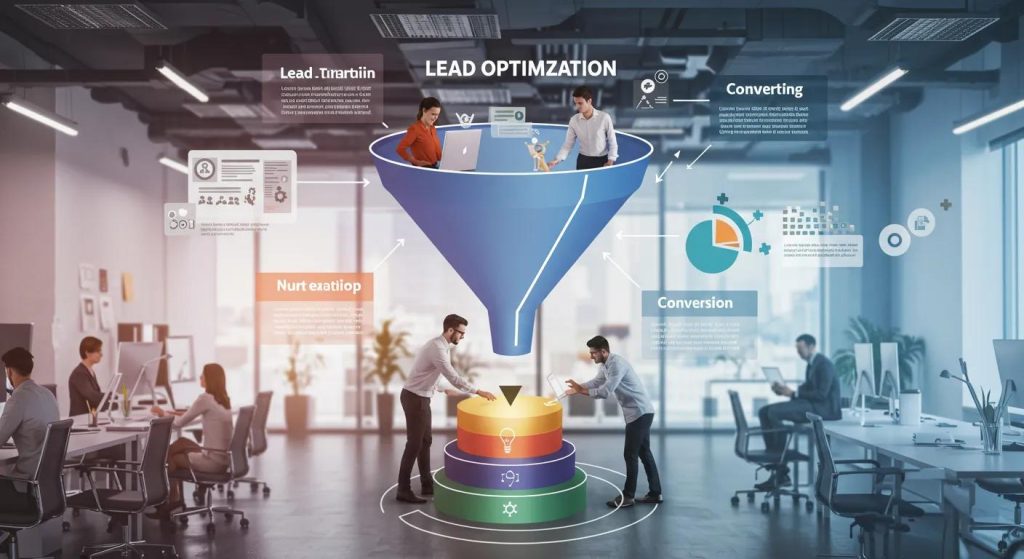How Pay Per Lead Services Elevate Sales Strategies
How Pay Per Lead Services Can Transform Your Sales Funnel for Better Business Growth
Pay-per-lead services offer a performance-first approach to acquiring customers by investing only for validated, qualified leads that meet agreed criteria. This model reduces initial outlay and aligns marketing incentives with sales outcomes, helping businesses create predictable funnel inputs and accelerate pipeline growth. In this discussion, you’ll discover what pay-per-lead services are, how they work compared with other acquisition models, the core benefits for lead quality and managing your investment, and practical steps to integrate pay-per-lead into your existing sales process. We will map pay-per-lead actions to funnel stages, examine Australia-specific considerations for providers, and provide a clear onboarding checklist and KPIs to measure ROI. Throughout, terms like pay-per-lead services, pay-per-lead marketing, CPL, CPA, CRM integration, and lead validation are used to build a semantic picture that connects marketing deliverables to sales performance. After reading, you will have tactical next steps to pilot pay-per-lead campaigns and understand how aligned SLAs and validation rules can help optimise conversion rates and revenue.
What Are Pay-Per-Lead Services and How Do They Work?
Pay-per-lead services are a performance marketing model where businesses invest only for leads that meet pre-defined qualification criteria. The mechanism typically follows a flow: targeting → capture → qualification → delivery → tracking/payment, with lead validation and SLA checks ensuring quality before investment. This optimises your marketing investment because vendor incentives focus on delivering intent-driven prospects rather than clicks or impressions. Key metrics to monitor include cost per lead (CPL), lead-to-SQL conversion, and lead validation pass rates, which together show how delivered leads translate into pipeline value. Understanding this process clarifies how pay-per-lead differs from other performance models and prepares teams to set effective SLAs.
How does pay-per-lead marketing differ from traditional lead generation?
Pay-per-lead marketing involves an investment for qualified, deliverable leads, whereas traditional approaches like CPC or CPM involve an investment for exposure and clicks irrespective of outcome. This approach places the focus on results, ensuring you invest in leads that truly matter. Providers often implement validation checks—phone verification, form validation, and initial intent scoring—to ensure leads match the business’s ICP and help reduce fraud. The result is clearer ROI attribution and tighter alignment between marketing investment and sales results, which is especially valuable when margin and conversion certainty matter.
What types of businesses benefit most from pay-per-lead services?
High-LTV B2B services, professional services, local service providers, and industries with clear qualification rules tend to gain most from pay-per-lead models. These businesses benefit because they can define precise lead criteria, measure downstream conversion, and justify the investment in higher-quality inbound prospects. Pay-per-lead for local businesses leverages geo-targeting and time-zone alignment to increase contact rates, while B2B buyers gain from pre-qualified inquiries that accelerate sales cycles. Selecting this model makes sense when sales teams can reliably follow up and convert incoming leads into measurable opportunities.
What Are the Key Benefits of Pay Per Lead Services for Businesses?

Pay-per-lead services deliver predictable funnel inputs and align vendor incentives with conversion outcomes, improving investment control and lead quality through agreed SLAs and validation. The mechanism—focused targeting, pre-qualification, and delivery SLAs produce higher-intent leads that are easier for sales teams to convert. This model supports scalable growth because your investment adjusts with performance, and businesses can forecast pipeline volume more accurately. Below is a compact comparison of the primary benefit entities, the mechanism that delivers them, and typical metric improvements you can expect.
Pay-per-lead services support clear ROI tracking and operational alignment, which naturally leads to practical examples of how lead quality and investment advantages manifest in conversion metrics.
Pay-per-lead services offer concrete benefits across several dimensions:
- Improved Lead Quality: Qualification rules and validation reduce time wasted on unfit prospects.
- Investment Predictability: Investing per qualified lead simplifies forecasting and budget allocation.
- Scalability: Your investment scales with results, allowing controlled expansion of lead volume.
- Aligned Incentives: Providers focus on leads that convert, not clicks that don’t.
These benefits mean that operationally, you can set SLAs and measurement frameworks that translate leads into pipeline growth.
| Benefit | Mechanism | Typical Metric Improvement |
|---|---|---|
| Lead Quality | Pre-qualification + validation checks | Higher lead-to-SQL conversion (10–30% uplift typical) |
| Investment Predictability | Investment per validated lead | Stable CPL and improved forecasting accuracy |
| Scalability | Performance-based allocation | Controlled increase in qualified lead volume |
| Incentive Alignment | SLAs and replacement policies | Reduced lead waste and faster optimisation |
This table demonstrates how specific mechanisms map to measurable improvements, making the business case for pay-per-lead clearer.
How can pay-per-lead services improve lead quality and conversion rates?
Pay-per-lead improves lead quality by enforcing qualification criteria at capture and by using validation checks before delivery, which increases the likelihood that leads are sales-ready. Tactics include targeted keyword and audience selection, pre-call screening, mandatory fields that capture intent signals, and manual verification for high-value segments. These actions reduce false positives and ensure sales teams receive leads with a higher propensity to convert, shortening sales cycles and increasing lead-to-opportunity rates. Continuous optimisation based on conversion feedback further improves quality over time, creating a virtuous cycle between marketing and sales.
What investment advantages do pay-per-lead models offer compared to other marketing methods?
The primary investment advantage of pay-per-lead is focused allocation: businesses make a focused investment, avoiding payment for low-value clicks or impressions and instead investing only when a lead meeting their criteria arrives. This manages initial investment and enables tighter CPL control, making budget forecasts more reliable. Example scenarios often show lower effective CAC when conversion rates from delivered leads are higher than from untargeted channels. Pay-per-lead also simplifies testing and scaling since providers can adjust targeting parameters quickly based on lead performance, enabling smarter allocation of your marketing budget.
How Can Pay-Per-Lead Services Optimise Your Sales Funnel?

Pay-per-lead services most directly impact the middle and bottom of the funnel by delivering qualified prospects ready for sales engagement, thereby increasing funnel throughput and conversion velocity. The mechanism involves intent-driven targeting for top-of-funnel discovery, qualification filters for mid-funnel nurturing, and validation with routing SLAs for bottom-funnel handoffs. This alignment reduces friction in lead follow-up and improves lead-to-opportunity conversion rates through faster contact and clearer handover rules. Operationally, integrating pay-per-lead into CRM workflows, defining lead scoring, and enforcing SLA response windows are essential steps to ensure the funnel benefits are realised.
Which stages of the sales funnel are most impacted by pay-per-lead marketing?
The middle and bottom funnel stages receive the largest uplift because pay-per-lead focuses on delivering interest that meets qualification thresholds, typically translating to faster conversion. Mid-funnel nurturing becomes more efficient when leads already express relevant intent, requiring fewer touches to become opportunities. Bottom-funnel efficiency improves with validated contact details and routing rules that ensure timely follow-up, which shortens sales cycles and increases close rates. These improvements depend on consistent lead scoring and SLA adherence between marketing and sales teams.
How does targeted lead generation enhance sales funnel efficiency?
Targeted lead generation—using geo, intent, demographic, and behavioural signals—produces leads that match buyer intent and business ICP, which raises conversion rates and reduces wasted effort. When leads arrive with context (source, intent keywords, prior actions), sales teams can personalise outreach and accelerate qualification. This reduces average time-to-contact and improves lead-to-opportunity ratios, which ultimately lowers CAC. Tight targeting also enables segmentation strategies that feed tailored nurture streams, increasing the probability that each lead progresses down the funnel.
| Funnel Stage | PPL Action | Expected Outcome |
|---|---|---|
| Top (Awareness) | Intent keyword targeting | Better-quality discovery traffic |
| Middle (Consideration) | Pre-qualification forms + scoring | Higher lead-to-opportunity rates |
| Bottom (Decision) | Validation + SLA routing | Shorter sales cycles and higher close rates |
This mapping clarifies how specific pay-per-lead actions influence measurable funnel outcomes and sets expectations for conversion lifts.
As a practical partner in this process, Results Agency—specialising in Lead Generation and operating as an Information Hub—applies measurable service level agreements and validation routines designed to ensure delivered leads feed the correct funnel stage and aim to improve sales outcomes. Their approach focuses on integrating pay-per-lead workflows into CRM systems and delivering ongoing conversion analysis to refine targeting and improve ROI.
Why Choose Pay Per Lead Services in Australia?
Choosing pay-per-lead services in Australia offers advantages related to local market knowledge, time-zone alignment, and compliance with domestic data handling expectations, all of which improve contact rates and lead relevance. Australian buyers show specific search and contact patterns that local providers can exploit through tailored geo-targeting and scheduling. Additionally, providers familiar with Australian regulations and privacy practices can design data collection and storage processes that reduce compliance risk. Evaluating providers for local experience, SLA transparency, and reporting capabilities helps you work towards converting leads at scale.
What makes pay-per-lead services in Australia unique or effective?
Local relevance is a major differentiator: providers that understand Australian search behaviour, market fragmentation, and timezone effects can increase contact success and conversion outcomes. Australian-specific campaigns benefit from regionally tuned keywords, local ad placements, and culturally appropriate messaging that raise intent signals. Compliance with local data expectations and clear handling processes also encourages higher conversion rates because prospects respond better when privacy and consent are transparently managed. This local expertise shortens ramp-up time and boosts the effectiveness of pay-per-lead programs.
How to select the best pay-per-lead providers in Australia?
Select providers by requesting case studies that demonstrate conversion metrics, asking for detailed SLA terms, and verifying lead validation and replacement policies. Evaluate their reporting cadence and CRM integration options to ensure smooth lead routing and attribution. Ask for references from businesses with similar ICPs and require sample lead data fields to confirm fit. These checks help mitigate the risk of poor-quality leads and support scaling your pilot with more predictable outcomes.
Intro: This checklist highlights practical vendor-selection criteria.
- Ask for documented conversion metrics and case studies from similar industries.
- Require explicit SLA terms, including lead validation and replacement policies.
- Confirm CRM integration capabilities and reporting frequency.
Using this checklist helps buyers choose providers who aim to deliver measurable, scalable results. The next practical area is onboarding—how to start and measure a pilot program.
How to Get Started with Lead Generation Pay Per Lead Services?
Starting with pay-per-lead requires clear qualification rules, CRM integration, pilot design, and KPI agreements to measure performance—these steps form the foundation of a successful program. Begin by defining your ideal customer profile (ICP) and the exact qualification criteria that constitute a lead for which you’ll invest. Next, map lead delivery into your CRM with routing rules and set SLA response expectations for sales teams to ensure timely follow-up. Run a controlled pilot to validate lead quality and optimise targeting before scaling your investment, and use agreed KPI dashboards to govern decisions.
What are the first steps to implement pay-per-lead marketing in your business?
Begin with a concise 5–7 step checklist: define ICP and qualification rules, configure CRM intake and routing, agree SLAs for lead handling, set up tracking and reporting, run a pilot, review conversion metrics, and iterate targeting based on outcomes. Each step assigns owners and timelines so responsibilities are clear and handoffs are seamless. Pilot campaigns should have a defined sample size and a measurement window to judge effectiveness before increasing volume. Starting methodically reduces risk and accelerates learning across marketing and sales teams.
| Phase | Task | Deliverable |
|---|---|---|
| Onboard | Define ICP & qualification | Written lead criteria |
| Integrate | CRM mapping & routing | Automated lead intake |
| Pilot | Run a controlled campaign | Pilot report with KPIs |
| Scale | Optimize & expand | Increased volume with maintained CPL |
How to measure success and ROI from pay-per-lead campaigns?
Measure success using a small set of core KPIs: CPL, lead-to-opportunity rate, opportunity-to-close rate, revenue per lead, and LTV: CAC ratio. Establish reporting cadence—weekly for operational metrics and monthly for ROI analysis—and assign a single owner for measurement to ensure consistent attribution. A simple ROI formula uses average revenue per closed deal multiplied by the closed rate from leads, minus your lead investment, to calculate net return and payback period. Regular review meetings between marketing and sales ensure continuous optimisation and that SLAs remain meaningful.
- Define core KPIs: CPL, lead-to-opportunity, close rate, revenue per lead.
- Set reporting cadence: weekly operational checks, monthly ROI reviews.
- Assign ownership: a single point to reconcile leads to revenue.
These measurement practices create the transparency needed to decide whether to scale a pay-per-lead program or refine qualification and targeting. For businesses ready to pilot, Results Agency can partner to design measurable trials and integrate performance dashboards to support data-driven scaling aligned with your sales process.




